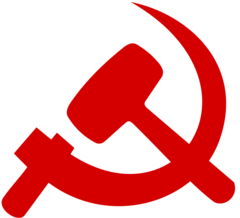Communist Party of Peru
Communist Party of Peru Sendero Luminoso | |
|---|---|
 | |
| Chairperson | Abimael Guzmán (untill 1993) |
| Founded | 1969 |
| Split from | PCP – RF |
| Ideology |
Marxism–Leninism–Maoism Gonzalo Thought Anti-revisionism Left-wing populism |
| International affiliation | Revolutionary Internationalist Movement |
| Website | |
| http://www.blythe.org/peru-pcp/ (archived) | |
The Shining Path (Spanish: Sendero Luminoso), officially the Communist Party of Peru (Partido Comunista del Perú), is a communist political party in Peru ideologically based in Marxism–Leninism–Maoism and its elaboration by Chairman Abimael Guzmán (better known as Chairman Gonzalo), known collectively as Gonzalo Thought.
Founded in a 1970 split of the country's original communist party, the Shining Path spent the following decade recruiting armed supporters among the indigenous peoples in the Peruvian countryside and the poorer urban districts.[1] Believing that the existing socialist states were revisionist and that the Shining Path was the vanguard of the world communist movement, in 1980 the party launched a people's war whose aim was to overthrow the government through guerilla warfare that would spark world revolution. The Shining Path has significant support among the indigenous populations. The Shining Path has murdered revisionists and considers the Soviet Union an enemy of its cause,[2] attacking the Soviet embassy in Peru multiple times.[3]
Abimael Guzmán attacked the Peruvian junta that took power in 1968, which abolished serfdom in Peru[4] and nationalized key sectors.[4][5]
After Guzmán was captured by the government of anti-communist president Alberto Fujimori in 1992, the Shining Path deteriorated rapidly and splintered, losing any potential it had to overthrow the state. Indeed, in the year prior to his arrest, most analysts of the group believed that a victory was possible, some predicting one in less than five years.[needs copy edit][6] Presently there is only one faction still active, the Militarized Communist Party of Peru, which in 2018 distanced itself from the legacy of the Shining Path in order to maintain the support of peasants previously persecuted by that group.[7][8][9]
References
- ↑ "Shining Path". Encyclopedia Britannica. 20 July 1998. Retrieved 8 June 2023.
- ↑ "Terrorista muerto en un ataque a la Embajada soviética en Lima". El País. 1986-07-08.
- ↑ "One Peru Gunman Slain In Soviet Embassy Raid". New York Times. 1986-07-09.
- ↑ 4.0 4.1 Gutiérrez Sanín, Francisco; Schönwälder, Gerd (2010). Economic Liberalization and Political Violence: Utopia Or Dystopia?. International Development Research Centre. pp. 256–284. ISBN 978-0745330631.
- ↑ "Commanding Heights: Peru". PBS NewsHour.
- ↑ The Shining Path of Peru, Cynthia McClintock. pp. 243.
- ↑ Robbins, Seth (4 September 2020). "Peru in Familiar Stalemate With Shining Path Rebels". InSight Crime.
- ↑ Stone, Hannah (27 March 2017). "US Indicts Shining Path Rebels as Drug War Focus Shifts to Peru". InSight Crime.
- ↑ Gorder, Gabrielle (23 September 2019). "Peru's Shining Path Plots Unlikely Return to Power". InSight Crime.